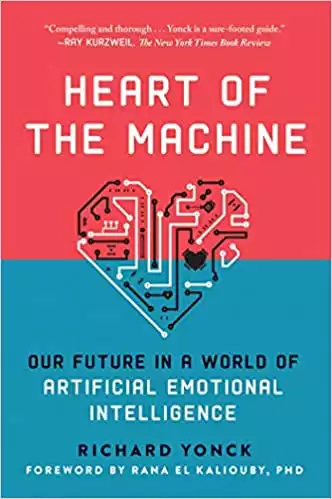Introduction
What is the meaning of AI? Artificial intelligence (AI) used to be the subject of science fiction movies. In 2022, this technology has started transforming our everyday lives. Without necessarily noticing, most of us use devices and apps based on AI technology in our personal and professional lives.
Those technologies have been designed to make daily chores easier and help optimize and automate any number of processes. Arguably, AI is improving human existence. And whilst many of us are using the term regularly, do you really know what AI means? Here is an in-depth look at artificial intelligence, its present, and its future.
Artificial intelligence is a branch of computer science that aims to build smart machines that can simulate the behavior of humans or show characteristics of the human mind. Two major characteristics include problem-solving and learning.
Table of contents
What is the meaning of AI?
Scientists have tried to redefine what artificial intelligence means and have introduced rationality into the definition. According to this new understanding, for a machine to be smart, it needs to act rationally.
Artificial intelligence may only recently have become a buzzword, but it has a long history as an academic discipline and an even longer history in fiction. Mary Shelley’s novel ‘Frankenstein’ has been credited with being the first fictional account of AI. However, there is evidence of intelligent artificial beings appearing in Ancient Greek storytelling centuries earlier.
Some of the first scientific approaches to AI were made in the 1940s and early 1950s. In 1956, artificial intelligence research was born as a scientific field of its own, following a workshop at Dartmouth College in New Hampshire. Early AI scientists taught computers how to play games and solve algebra problems.
Over the following decades, the field went from periods of heightened optimism to funding cuts and back again. As a result, some developments were started but never finished. New developments and approaches renewed the enthusiasm for AI technology. At the beginning of this century, even laypersons can clearly see the potential benefits of the technology.
Some of the most widely used current examples of AI include the recommendations users receive from services like Amazon or Netflix. The application learns what a person likes to watch, read, or purchase and subsequently suggests related products.
Voice recognition technology is another widespread application of AI. Smart home assistants like Alexa have learned to understand human speech and carry out instructions. Siri allows users to control their iPhones through voice commands.
AI is also widely used in commercial applications. Public transportation is one such example. But artificial intelligence technology has also found its way into climate change applications and policing strategies. Keep reading for a closer look at current applications of AI technology.
It is certainly safe to say that AI has come a long way from the original Greek depictions or the account of Frankenstein’s monster. Current applications are also outperforming more recent science fiction movie predictions.
Also Read: Automation vs AI: What is the Difference, Why is It Important?
Why is it called “Artificial Intelligence”?
Artificial intelligence mimics human intelligence, but it is not the same. A simple way of distinguishing between the two is to think of the human mind as possessing real intelligence, whereas smart machines are simply mimicking that intelligence.
Some of the early approaches to AI included attempts to build an electronic brain. Whilst that expression is not used all that often anymore, AI programming continues to focus on three cognitive processes that are usually accomplished by the brain. Those processes are learning, self-correction, and reasoning.
Smart machines need a solid foundation of specialized hardware and software to attain and hone these skills. Over time, smart machines take in huge amounts of data that would exceed the capacity of a human brain. The machines analyze the data supplied by humans. They are looking for patterns and other correlations. Once found, those patterns then become the basis of predictions for the future.
AI technology not only has the capacity of digesting more data in less time than humans can. Its modeling capability may also exceed human imagination because it is based on more input. Learning is a core skill of AI technology. As the application or software receives more input, it corrects its outputs. The results are more life-like conversations with home assistants and better customer service delivery through chatbots, for example.
How does AI work?
Artificial Intelligence, or AI, is a broad field of computer science that emulates human intelligence in machines, imbuing them with the capacity to learn from experience, adapt to new inputs, and execute tasks that would typically require human intellect. At the core of AI lies the concept of algorithms, which are essentially sets of instructions or rules that the AI system follows to solve problems or achieve a particular goal.
A pivotal part of how AI works is machine learning, a subset of AI that involves the practice of using algorithms to parse data, learn from it, and then make predictions or decisions. Rather than being explicitly programmed to perform a specific task, machine learning models are trained on vast amounts of data and improve their performance as they gain more exposure to the data. For instance, a machine learning model trained to identify images of cats would get better at its task the more images of cats it is exposed to.
Deep learning, a subfield of machine learning, is another key aspect of AI. It employs artificial neural networks, which are inspired by the human brain’s structure and function, to process data. These networks consist of layers of nodes, each layer receiving input from the previous layer, processing it, and passing it on. Deep learning excels at processing unstructured data and is the driving force behind many advanced AI applications like voice recognition, image recognition, and natural language processing.
Reinforcement learning, another subset of machine learning, involves AI systems learning how to behave in an environment by performing certain actions and observing the results or rewards. By making numerous attempts and adjusting their strategies based on the rewards received, these AI systems can learn to make optimal decisions. For example, reinforcement learning is used in self-driving cars where the AI system learns to navigate the road and avoid obstacles based on feedback from its environment.
The workings of AI are a blend of complex algorithms, machine learning, deep learning, and reinforcement learning. These components enable AI systems to learn, adapt, and perform tasks with varying degrees of autonomy, ultimately improving their performance without being explicitly programmed to do so.
Types of Artificial Intelligence
Despite the widespread use of the term AI, the concept is not as homogenous as it may sound. There are clear distinctions between different types of AI. Scientists use these categories to clarify which type of AI they are referring to.
Strong AI vs Weak AI
One of the most basic distinctions to apply to AI technology is the difference between strong artificial intelligence and weak AI.
Strong AI is also called artificial general intelligence (AGI). This term covers AI that can replicate the cognitive capabilities of humans. In practice, that means the application can be presented with a problem it has not encountered before and use its abilities to solve that problem.
This kind of strong AI program should be able to pass the Turing test, named after mathematician and codebreaker Alan Turing. To pass this test, a computer needs to solve a problem in a way that is indistinguishable from a human solution.
Weak AI, on the other hand, tends to have a much narrower remit. Technologies like Siri or Alexa have been trained to complete specific tasks. During everyday use, it may seem like these assistants can take care of an endless list of tasks.
However, in reality, that list is very much limited to the tasks for which the assistants have been trained. For that reason, weak AI is also called narrow AI.
Four Types of AI
Another way of categorizing AI was developed by Arend Hintze of Michigan State University. In 2016, Hintze specified four types of artificial intelligence starting with machines many people use today and progressing to potential future developments.
The four types of AI are:
- Reactive machines
- Limited memory
- Theory of mind
- Self-Awareness
Reactive Machines
This type of AI includes systems that are specifically designed to do certain tasks and cannot be trained to perform anything beyond their programmed functions. For instance, Deep Blue, a chess program developed by IBM, falls under this category. Deep Blue can identify pieces on a chessboard and understand how each move will alter the state of the game. It can predict the opponent’s moves and choose the most optimal move from the given possibilities. However, Deep Blue has no concept of the past, nor any ability to foresee the future. It doesn’t use any data from previous games to make decisions. It’s reactive, making decisions based solely on immediate, in-game scenarios.
Limited Memory AI
Limited memory AI can make informed and adaptive decisions based on past data fed into their memory. These machines learn from historical data to make predictions. They do not have the capability to form “experiences” but can process large amounts of stored data. A common example of limited memory AI is self-driving cars. These cars observe the speed and direction of other vehicles through sensors, storing this data to make more informed decisions in the future.
Theory of Mind AI
Theory of Mind AI is a more advanced type of AI that has the ability to understand thoughts and emotions affecting human behavior. It can understand that each individual might have different thoughts and feelings that affect their actions. This type of AI remains largely theoretical and hasn’t been fully realized yet. This class of AI will play an important role in human-computer interaction (HCI) and computer-mediated communication (CMC) where understanding human feelings and thoughts is essential.
Self-Aware AI
This is the pinnacle of AI research, incorporating all the previous types and adding a self-awareness factor. This AI will have its own consciousness, emotions, and be aware of its own state in the world. It will understand, learn, adapt, and be able to reason about itself. This type of AI will not only be able to predict the behavior of others, but also predict its own behavior. This form of AI remains hypothetical and hasn’t been realized yet.
Deep learning vs. Machine learning
At the beginning of this blog article, we said that AI is a wide area of computer science. Now it is to narrow it down a little with the help of the terms machine learning and deep learning. Although both are closely related to each other and the concept of AI as a whole, there are a few important differences.
Machine Learning
Machine learning is a subcategory of artificial intelligence. Its goal is to prepare computers to complete specific tasks without needing specific programming every time the computer needs to perform the task in question.
Scientists and programmers achieve that by supplying computers with large amounts of data and training the machines to evaluate the data more accurately over time. As the computer learns, it improves its ability to act on the data it is receiving.
For machine learning to work effectively, data needs to be entered in a structured way, including columns and rows. Based on that input, the application or program becomes more self-reliant over time.
Deep Learning
Deep learning is a subset of machine learning and takes that approach one step further.
Machine learning allows computers to become self-reliant in their assessment of information. However, there are major limitations to how the machine deals with the data it received because it continues to act like a machine. As a result, it cannot compete with human intelligence.
Deep learning addresses this shortfall by taking a far more sophisticated approach to machine learning. Deep learning programs are specifically modeled on the neural networks of the human brain.
Those networks process data in more abstract ways that simulate the type of processing in a human brain. Making deep learning work relies on huge volumes of data, whilst machine learning works well based on comparatively smaller volumes of information. Over time, deep learning algorithms require less human intervention than machine learning.
Also Read: What is Deep Learning? Is it the Same as AI?
Artificial Intelligence Applications
The role of Artificial Intelligence has been rapidly expanding, impacting a wide variety of industries and applications. Today, AI systems are capable of tasks that until recently were thought to belong solely to the domain of human intelligence.
A prominent example of AI’s early achievements is IBM’s Deep Blue, which made headlines in 1997 when it defeated world chess champion Garry Kasparov. This was a pivotal moment in the history of AI, showing that an AI system could outsmart a human in a highly complex strategic game. Since then, the complexity and versatility of AI systems have significantly advanced.
Today, one can see AI applications in everyday life through voice assistants like Amazon’s Alexa or Apple’s Siri. These virtual assistants employ AI technologies such as speech recognition and natural language processing (NLP) to interact with users in human language, accomplishing tasks like setting reminders, playing music, or providing weather updates. Expert systems, another AI application, are used in numerous fields such as medical diagnosis and financial investing, where they leverage their vast store of encoded expert knowledge to provide insightful recommendations.
AI’s capabilities extend beyond language and into vision, with facial recognition technology being a prominent example. This technology is used in a variety of applications, ranging from unlocking smartphones to identifying suspects in security footage. Another critical application of AI is in Robotic Process Automation (RPA), which is used to automate repetitive tasks, thereby improving efficiency and reducing errors.
Generative AI models have started to emerge as another revolutionary application of AI. These models, like OpenAI’s Generative Pre-trained Transformers (GPT) or DALL-E image generator, leverage the abilities of language models to generate new, creative content. GPT, for example, can generate coherent and contextually relevant sentences based on the input provided, while DALL-E can generate unique images from text descriptions. These applications showcase the versatility and creative potential of AI, extending its reach from strictly analytical tasks to more artistic and creative domains. AI is increasingly being used in predictive maintenance in industries such as manufacturing and energy, predicting equipment failures before they happen and scheduling maintenance to prevent costly downtimes.
The applications of AI are vast and growing, reaching into virtually every sector of society. From enhancing our interactions with technology to automating mundane tasks, improving security, and even venturing into the realm of creative content generation, AI continues to push the boundaries of what is technologically possible.
The Future of AI
Experts predict that artificial intelligence technology will become a part of every industry and enter all aspects of our personal lives. Already, the number of applications of the first two types of AI continues to grow almost daily. Narrow, or weak, AI has found its way into virtually any industry sector already.
As scientists develop ever most sophisticated types of this technology, its usefulness will only grow. Adding consciousness and self-awareness to the capabilities of current AI will bring the technology closer to human intelligence. Computers will be able to do more with less human intervention.
Is there a limit to what AI can achieve? At this time, it appears that the limit really is human imagination. As this technology develops, applications and uses may expand well beyond what we can imagine today.
Conclusion
Artificial Intelligence (AI) stands at the intersection of technology and human thought processes, a field that continues to evolve and reshape the way we interact with the world. With the discovery of transformers, AI has witnessed game-changing improvements, opening the door to a new wave of possibilities. Cutting-edge AI models, like the GPT-4 language model, have shown impressive capabilities in understanding and generating human-like text, revealing how close we are getting to truly mimicking human cognition.
This growth in AI is not solely due to advancements in software and algorithms. The hardware innovations that power these largest models have equally contributed to the phenomenal leaps we see in the field today. Companies like Google, with its DeepMind project, have made significant strides in developing foundational models and popular algorithms that power everything from our daily search engine queries to advanced image generation tasks.
One cannot overlook the role of machine learning, a subset of AI, in shaping the modern field of artificial intelligence. Advances in machine learning, particularly the development of deep learning techniques and the creation of various deep learning frameworks, have revolutionized how we approach problems. By using these techniques, AI-based systems can now learn from large volumes of data and make predictions with a level of accuracy that was unthinkable a few years ago.
AI is no longer just a theoretical concept or a mathematical theorem; it is an evolving reality that is changing the way we live and work on a daily basis. The game-changing improvements brought by AI, from the GPT-4 language model to Google DeepMind’s foundational models, are accelerating the time to market for various products and services, and are influencing business models across various industries. As we continue to innovate and advance this technology, we can only expect AI’s influence to grow more profound.
References
Crawford, Kate. The Atlas of AI: Power, Politics, and the Planetary Costs of Artificial Intelligence. Yale University Press, 2021.
Daugherty, Paul R., and H. James Wilson. Human + Machine: Reimagining Work in the Age of AI. Harvard Business Press, 2018.
Lee, Kai-Fu, and Chen Qiufan. AI 2041: Ten Visions for Our Future. Currency, 2021.












